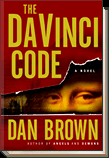 |
Kirsti Copeland Ph.D. in Early Christianity Adjunct Lecturer, Stanford University Book Discussion: The Da Vinci Code
The Round Room, Memorial Church,
Edited by Peter Y. Chou |

Dan Brown's |
|
Transcribed from Kirsti Copeland's Handout: "Breaking the Da Vinci Code" The heresies, then provided us with no decisive confirmation of a connection between Jesus' family and the Merovingians, who appeared on the world stage some four centuries later. For such confirmation we were obliged to look elsewhere— back to the Merovingians themselves. At first glance, the evidence, such as it was, seemed to be meager. We had already considered the legendary birth of Merovee, for example— child of two fathers, one of whom was a mysterious aquatic creature from across the sea... And while the Merovingian royal bloodline was credited with a sacred, miraculous and divine nature, it was not explicitly stated anywhere that this blood was, in fact, Jesus. — Michael Baignet, Richard Leigh, Henry Lincoln, Holy Blood, Holy Grail, (1982) p. 387
There is complete silence in the Gospels concerning the marital status of Jesus.
No wife accompanies him in his public career, or, for that matter, stays at home...
Such a state of affairs is sufficiently unusual in ancient Jewry to prompt further enquiry...
Rabbi Eliezar ben Hyrcanus even went so far, at the end of the first century AD, as to
compare deliberate abstention from procreation to murder; and so did his contemporary,
Simeon ben Azzai. As Simeon was himself unmarried, this exposed him to the criticism of
his colleagues... he pleaded unceasing devotion to biblical study... The outlook of the
early Hasidim in this respect is not expressed verbally in the sources... Among these are
devoutness, humility and the fear of sin, but also sexual abstinence and the holy spirit
which is the hallmark of prophecy.
From this, Irenaeus says, the Valentinians derive direct implications concerning sexual activity.
Those who have experienced that "mystery of syzygies" are enjointed to enact marital intercourse
in ways that express their spiritual, psychic, and bodily integration, celebrating the act as a
symbol of the divine pleromic harmony... Some scholars (myself included) have sometimes taken
Irenaeus's statement as evidence that Valentinian Christians rejected the ascetic practice that
other Gnostic Christians based upon similar exegesis... Yet now I find myself more cautious about
drawing such implications... The inconclusiveness of the evidence suggest to me that Valentinian
Christians like the orthodox, may have expressed a wide range of views and tolerated a wide variety
of practices... Whether the sources remain silent on the literal question, they speak clearly
concerning the symbolic ones.
The whole tradition of considering ancient pagan religion sexy and its women cultic functionaries
as sex partners is a myth. It speaks more about its adherents than about the ancients. It is born
of conflicted attitudes towards sexual activity in Western civilization, of the inability to think
of roles for women priestesses in any area other than sexual. Nevertheless, it points out the absence
of biblical discourse on sexuality. It is hard to imagine that ancient Israel did not have more to
say about sexuality than the Bible offers.
[11] Then said Judah to Tamar his daughter-in-law, "Remain a widow at thy father's house,
till Shelah my son grows up"— for he feared that he would die, like his brothers.
So Tamar went and dwelt in her father's house. [12] In course of time the wife of Judah,
Shua's daughter, died; and when Judah was comforted, he went up to Timnah to his sheepshearers,
he and his friend Hirah the Adullamite. [13] And when Tamar was told, "Your father-in-law is
going up to Timnah to shear his sheep," [14] she put off her widow's garments, and put on a veil,
wrapping herself up, and sat at the entrance to Enaim, which is on the road to Timnah;
for she saw that Shelah was grown up, and she had not been given to him in marriage.
[15] When Judah saw her, he thought her to be a harlot, for she had covered her face.
[16] He went over to her at the road side, and said, "Come, let me come in to you,"
for he did not know that she was his daughter-in-law. She said, "What will you give me,
that you may come in to me?" [17] He answered, "I will send you a kid from the flock."
And she said, "Will you give me a pledge, till you send it?" [18] He said, "What pledge shall
I give you?" She replied, "Your signet and your cord, and your staff that is in your hand."
So he gave them to her, and went in to her, and she conceived by him. [19] Then she arose
and went away, and taking off her veil she put on the garments of her widowhood.
[20] When Judah sent the kid by his friend the Adullamite, to receive the pledge from the
woman's hand, he could not find her. [21] And he asked the men of the place,
"Where is the harlot (qedeshah) who was at Enaim by the wayside?" And they said,
"No harlot (qedeshah) has been here."
The Gospel of Philip Excerpts:
The Thunder, Perfect Mind Excerpts:
Gospel of Mary IX.3-9: |
![]()
| Top of Page
| Da Vinci Code
| WardGasque.html
| Elaine Pagels |
| Stanford Lectures
| Enlightenment News
| A-Z Portals
| Home |
![]()
| © Peter Y. Chou, WisdomPortal.com P.O. Box 390707, Mountain View, CA 94039 email: peter@wisdomportal.com (1-20-2004) |
 |